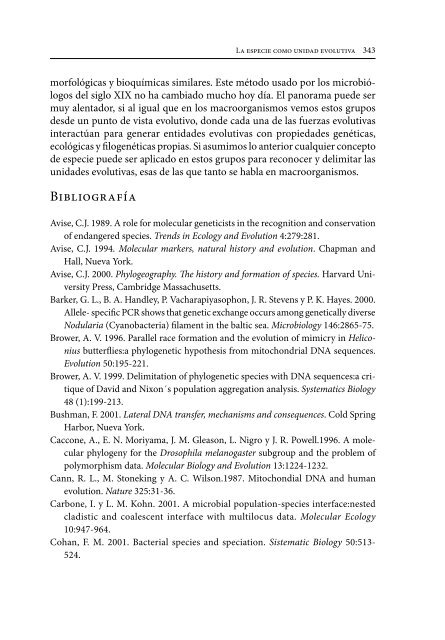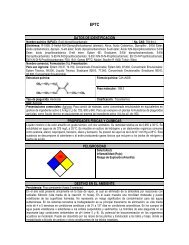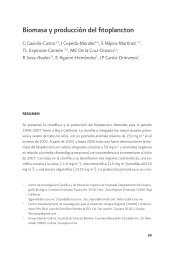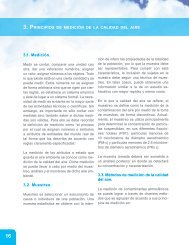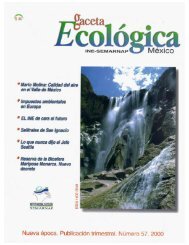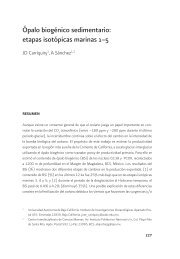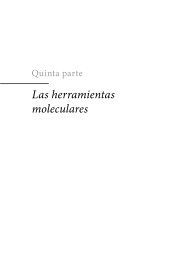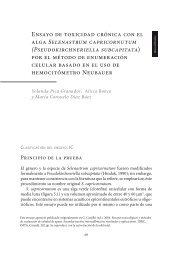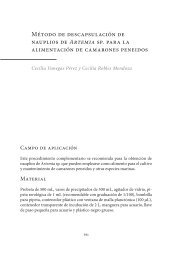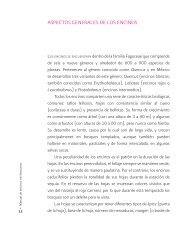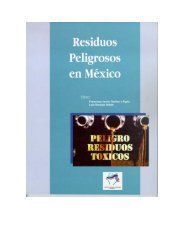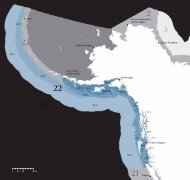La especie como unidad evolutiva: uso de marcadores moleculares ...
La especie como unidad evolutiva: uso de marcadores moleculares ...
La especie como unidad evolutiva: uso de marcadores moleculares ...
Create successful ePaper yourself
Turn your PDF publications into a flip-book with our unique Google optimized e-Paper software.
<strong>La</strong> <strong>especie</strong> <strong>como</strong> <strong>unidad</strong> <strong>evolutiva</strong> 343<br />
morfológicas y bioquímicas similares. Este método usado por los microbiólogos<br />
<strong>de</strong>l siglo XIX no ha cambiado mucho hoy día. El panorama pue<strong>de</strong> ser<br />
muy alentador, si al igual que en los macroorganismos vemos estos grupos<br />
<strong>de</strong>s<strong>de</strong> un punto <strong>de</strong> vista evolutivo, don<strong>de</strong> cada una <strong>de</strong> las fuerzas <strong>evolutiva</strong>s<br />
interactúan para generar entida<strong>de</strong>s <strong>evolutiva</strong>s con propieda<strong>de</strong>s genéticas,<br />
ecológicas y filogenéticas propias. Si asumimos lo anterior cualquier concepto<br />
<strong>de</strong> <strong>especie</strong> pue<strong>de</strong> ser aplicado en estos grupos para reconocer y <strong>de</strong>limitar las<br />
<strong>unidad</strong>es <strong>evolutiva</strong>s, esas <strong>de</strong> las que tanto se habla en macroorganismos.<br />
Bibliografía<br />
Avise, C.J. 1989. A role for molecular geneticists in the recognition and conservation<br />
of endangered species. Trends in Ecology and Evolution 4:279:281.<br />
Avise, C.J. 1994. Molecular markers, natural history and evolution. Chapman and<br />
Hall, Nueva York.<br />
Avise, C.J. 2000. Phylogeography. The history and formation of species. Harvard University<br />
Press, Cambridge Massachusetts.<br />
Barker, G. L., B. A. Handley, P. Vacharapiyasophon, J. R. Stevens y P. K. Hayes. 2000.<br />
Allele- specific PCR shows that genetic exchange occurs among genetically diverse<br />
Nodularia (Cyanobacteria) filament in the baltic sea. Microbiology 146:2865-75.<br />
Brower, A. V. 1996. Parallel race formation and the evolution of mimicry in Heliconius<br />
butterflies:a phylogenetic hypothesis from mitochondrial DNA sequences.<br />
Evolution 50:195-221.<br />
Brower, A. V. 1999. Delimitation of phylogenetic species with DNA sequences:a critique<br />
of David and Nixon´s population aggregation analysis. Systematics Biology<br />
48 (1):199-213.<br />
Bushman, F. 2001. <strong>La</strong>teral DNA transfer, mechanisms and consequences. Cold Spring<br />
Harbor, Nueva York.<br />
Caccone, A., E. N. Moriyama, J. M. Gleason, L. Nigro y J. R. Powell.1996. A molecular<br />
phylogeny for the Drosophila melanogaster subgroup and the problem of<br />
polymorphism data. Molecular Biology and Evolution 13:1224-1232.<br />
Cann, R. L., M. Stoneking y A. C. Wilson.1987. Mitochondial DNA and human<br />
evolution. Nature 325:31-36.<br />
Carbone, I. y L. M. Kohn. 2001. A microbial population-species interface:nested<br />
cladistic and coalescent interface with multilocus data. Molecular Ecology<br />
10:947-964.<br />
Cohan, F. M. 2001. Bacterial species and speciation. Sistematic Biology 50:513-<br />
524.


